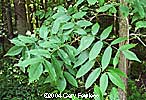
Trees of Wisconsin
|
Fraxinus nigra Marshall black ash Family: Oleaceae |
||||||||||||
|
||||||||||||
| Fraxinus
nigra is largely restricted to swamps. The sessile leaflets (no stalks)
are characteristic and the tips of the leaflets tend to droop. If branches
have good annual growth in length, the last pair of lateral
buds tend to be clearly separated from the terminal bud. The bark
of trees over about 3 inches in diameter is also often distinctive, although
difficult to describe. In addition to its peculiar appearance, the irregularly
shaped, narrow ridges of the bark are spongy under firm pressure of a
thumb or finger. See paragraph 2 of the description of Fraxinus
americana for the basic characters separating the Ash species.
There appears to be a tendency for people, even some resource management professionals, to identify an ash as Fraxinus nigra if it grows in a swamp. In the Green Bay area, southern Door County and much of southeastern Wisconsin, Fraxinus pennsylvanica is by far the commonest ash species in wet forests, especially if the canopy is open with a dense growth of Reed Canary grass (Phalaris arundinacea) beneath. In northern Wisconsin where the forests are more continuous and perhaps the swamps are more likely to be fed by ground water rather than surface water, Fraxinus nigra is more prominent. Fraxinus nigra is among the last of the trees to develop new leaves in the spring. This is apparently because they are very frost sensitive and the leaves quickly turn black if there is frost after they emerge. The leaves are also among the first to change color (yellow) and drop in the autumn. Comparison of leaves and twigs of Fraxinus americana, F. nigra and F. pennsylvanica. Comparison of fruits for Fraxinus americana, F. nigra and F. pennsylvanica. |
|





